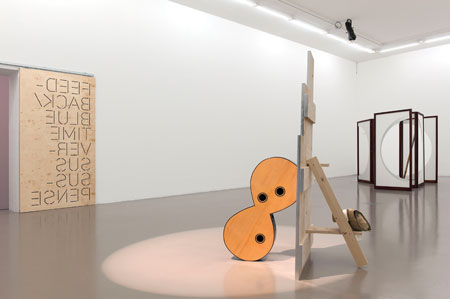Sadaâne Afif

Immediately upon entering Saâdane Afif’s exhibition at the Institut d’Art Contemporain, the visitor was presented with a mystery. After first passing through a hall of posters that seemed to promote various rock concerts but proved on closer inspection to derive from the artist’s previous exhibitions, I found myself in a square white room, empty but for a small black radio transmitter with a steel aerial measuring several feet and housed in Perspex. An inscription on the transmitter’s surface indicated it was ‘microprocessor controlled’ and ‘quartz-lock synthesized’, but this offered few indications of its meaning or purpose. The first clue, as so often in this exhibition, came via our ears.
The next room contained the receiver to that transmitter: a Tivoli Audio ‘Songbook’ portable radio. But before I could tune my auditory nerves to the songs it played, another sound caught my attention: an insistent ticking from a fourth room interceded, a reminder of the clock’s tyranny over recorded music; the music industry’s cult of youth, and the threat of extinction that hangs over the whole industry today. So, like a detective, I proceeded to piece together the puzzle; or, perhaps more aptly, like a psychoanalyst, scouring symptoms in search of a syndrome. The works in Afif’s exhibition, from sculptures and painted canvases to wall texts and found objects, could be the fragments dreamt by a frustrated musician, into which we plunge slowly deeper.
The ticking, it soon transpired, belonged to Blue Time (Sunburst) (2004). The titular ‘Sunburst’ refers to the characteristic finish of a Gibson Les Paul electric guitar, which proceeds from a golden yellow centre to a blackened edge, in imitation of the burnished French polish look of old wood. Afif’s work sees the body of such a guitar rendered useless, shorn of its neck and strings and formed into a perfectly smooth circle, with a jack lead connecting it to the ticking amplifier. This was the first of several un-instruments in the exhibition – instruments whose instrumentality had been removed, but retained the signifiers of instrument-ness. These sculptures vent a frustration, an impotence, even, while holding fast to the rock ’n’ roll myth.
The ticking of a clock or a metronome has a long history in performance art – from Fluxus to Marina Abramovic´. In this case, however, the tick-tock of Afif’s non-guitar pointed to the absence of a performer, and the increasingly untenable position of such a performer in society. On the show’s opening night, the various works were accompanied – obscured, in fact – by a performance of sorts, which itself pointed to another absent performance (never) to come: visitors were given a peek of a lone musician rehearsing, in a cordoned-off part of the gallery, for a gig that never took place. In some respects, Afif’s show could be seen as the logical extension of the Kickstarter phenomenon, whereby musicians are forced to offer their fans lyric sheets or
a day with the band in the studio, just to get their albums funded.
Like most popular music – and like the methods of psychoanalysis – Afif’s work takes an interpersonal, dialogic form. Since 2004, he has invited artists and writers to respond to his work in the form of songs and lyrics to be exhibited as adhesive letters on the walls alongside the works that inspired them. At the IAC, a 2004 text by Afif’s friend, the French artist Lili Reynaud Dewar, was repeated on several walls. Entitled Blue Time, its insistent refrain, ‘Oh I’ve been waitin’ for days … Cos waitin’ has to be my duty,’ encapsulates this sense of a compulsory, eternal deferral implied by a series of objects that circulate around an impossible performance. But, as Afif himself put it in an interview in 2010, while such poetic texts may ‘suggest the beginning of an explanation […] what you get is in fact an ever more abstract idea of the object.’
This simultaneous multiplying and stymieing of meaning would seem to be one of Afif’s master themes. Blank or reflective surfaces abounded throughout the exhibition. And although text is one of his most frequent recourses, the one place where we might have expected to find words – in the neon work Feedback [Blue Time vs Suspense (Blue Time)] (2009), which hung in the entrance to one of the rooms – there was only a mute squiggle. It may have been no coincidence that the amplifiers used in two of Afif’s pieces are digital machines that ‘model’ the sound of various classic valve amps. There is an acknowledgement, in the familiar clichés of Dewar’s lyrics, of the well-worn imagery of hobo musicians and sunburst guitars, that these gestures are no longer available to rock per se, that rock itself is now only capable of ‘modelling’ itself. But, in receding, the genre has left behind an iconography which, outside of its original context, retains a vast capacity for meaning. Afif’s work deconstructs this significant remainder with both deftness and irreverence.

















